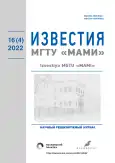Перезаряжаемые системы хранения электрической энергии для транспортных средств категории L
- Авторы: Дегтярев И.П.1, Курмаев Р.Х.1
-
Учреждения:
- Государственный научный центр Российской Федерации «НАМИ»
- Выпуск: Том 16, № 4 (2022)
- Страницы: 357-363
- Раздел: Электротехнические комплексы и системы
- URL: https://journal-vniispk.ru/2074-0530/article/view/126644
- DOI: https://doi.org/10.17816/2074-0530-108564
- ID: 126644
Цитировать
Полный текст
Аннотация
Введение. Мир высоких технологий и техники по законам природы не может находиться на одном месте, поэтому помимо традиционного автомобильного транспорта появились электромобили, электромотоциклы и другие транспортные средства с электрическими источниками питания. Ввиду создания электрических транспортных средств категории L, появляется необходимость в разработке и производстве перезаряжаемых систем хранения электроэнергии (ПСХЭ). Системы хранения электроэнергии по своей конструкции должна обеспечивать ряд требований, выдвигаемых к электрическим транспортным средствам категории L. Перезаряжаемая система хранения электроэнергии в составе электрического транспортного средства должна обеспечивать максимальный запас хода (высокую энергоемкость) и иметь достаточную прочность для обеспечения безопасности транспортного средства категории L. Для выполнения указанных требований одной из основных проблем является снижение массы каркаса ПСХЭ за счет применения легкосплавных материалов.
Целью исследования является повышение энергоэффективности 2-х колесного транспортного средства с электроприводом за счет разработки ПСХЭ, учитывающей массово-габаритные показатели.
Методы и средства. Применяется один из методов моделирования силовых элементов каркаса с одинаковой геометрической схемой, но c применением различных материалов (цветных сплавов). Происходит теоретическая симуляция нагрузок на силовые элементы каркаса и сравнение деталей, изготовленных из различных материалов.
Результаты. Проблема снижения массы ПСХЭ является одной из задач повышения эффективности электрических транспортных (ЭТС) средств категории L. Помимо увеличения запаса хода, снижение массы и инерционных показателей силовой части ПСХЭ ведет к улучшению маневренности и управляемости ЭТС. Стоит отметить, что и расположение перезаряжаемых систем хранения электроэнергии на электромотоцикле положительно влияет на энергоэффективность за счет снижения центра тяжести, что в свою очередь отражается на управлении электрическим транспортным средством категории L и его аэродинамике.
Выводы. Основной задачей, на сегодняшний день, при создании ПСХЭ для электрических транспортных средств (в том числе, и электромотоциклов) является снижение ее массы. Одним из направлений по ее решению является использование вариативных сплавов в конструкции каркаса ПСХЭ. В настоящей статье предложен способ расчета конструкции каркаса перезаряжаемой системы хранения электроэнергии, позволяющий оптимизировать материал и геометрию деталей, что позволяет снизить массово-габаритные показатели на 20%. Следующим этапом исследования будет изготовление опытного образца и практические испытания ПСХЭ для подтверждения теоретических расчетов.
Полный текст
Открыть статью на сайте журналаОб авторах
Иван Петрович Дегтярев
Государственный научный центр Российской Федерации «НАМИ»
Автор, ответственный за переписку.
Email: iIvan.degtyarev@nami.ru
ORCID iD: 0000-0001-5378-6578
ведущий инженер-конструктор центра «Информационные и интеллектуальные системы»
Россия, 125438, Москва, ул. Автомоторная, д. 2Ринат Ханяфиевич Курмаев
Государственный научный центр Российской Федерации «НАМИ»
Email: rinat.kurmaev@nami.ru
ORCID iD: 0000-0001-7064-0466
SPIN-код: 6483-2444
доцент, канд. техн. наук, директор научно-образовательного центра
Россия, 125438, Москва, ул. Автомоторная, д. 2Список литературы
- Razelli E. Prospects for Lead-Acid Batteries in the New Millennium // Journal of Power Sources. Vol. 116, N 1–2, P. 2–3. doi: 10.1016/S0378-7753(02)00675-4
- Anderman M. Brief Assessment of Improvements in EV Battery Technology since the BTAP June 2000 Report. Needham: Advanced Automotive Batteries, Режим доступа: https://www.tech-insider.org/electric-vehicles/research/acrobat/030327-2.pdf дата обращения: 05.06.2022.
- Cherry C., Cervero R. Use Characteristics and Mode Choice Behavior of Electric Bike Users in China // Transport Policy. 2007. Vol. 14, N 3. P. 247–257. doi: 10.1016/j.tranpol.2007.02.005
- Строганов В.И. Повышение эксплуатационных характеристик электромобилей и автомобилей с комбинированной энергоустановкой : дис. ... д-р техн. наук. Москва, 2014. Режим доступа: http://d21221704.samgtu.ru/sites/d21221704.samgtu.ru/files/dissertaciya_stroganov_18.10.14.pdf дата обращения: 05.06.2022.
- Оспанбеков Б.К. Повышение энергетической эффективности и эксплуатационных показателей электромобилей : дис. ... канд. техн. наук. Москва, 2017. Режим доступа: https://miit.ru/content/%D0%94%D0%B8%D1%81%D1%81%D0%B5%D1%80%D1%82%D0%B0%D1%86%D0%B8%D1%8F.pdf?id_wm=770923 дата обращения: 05.06.2022.
- Feng L., Jiang Y., Chen S. Problem Analysis and Policy Options for Electric Bicycle Development. Strategy Study of Urban Transport Development inChina. Beijing: Center for Sustainable Transportation, China Academy of Transportation Sciences, 2007.
- Патент РФ № 2563576 / 20.09.2015 Бюл. № 26. Хамбитцер Г., Хайтбаум И., Борк М. и др. Батарейная установка высокой мощности и способ управления батарейной установкой высокой мощности. Режим доступа: https://new.fips.ru/iiss/document.xhtml?faces-redirect=true&id=f4b0cfdb6790fa15fc7993d8b8650fe4 дата обращения: 05.06.2022.
- Патент РФ № 2589530 / 10.07.2016 Бюл. № 19. С.ан Х.е Ш. Силовая установка электромобиля, электромобиль и способ обогрева аккумуляторной батареи электромобиля. Режим доступа: https://new.fips.ru/iiss/document.xhtml?faces-redirect=true&id=34c4a21238de7148541fc03021e8f7a3 дата обращения: 05.06.2022.
- Патент РФ № 2570242 / 10.12.2015 Бюл. № 34. Венгер У., Колер Б.Р., Йенни Х.-Р. Электромобиль и зарядное устройство бортового аккумулятора для этого электромобиля. Режим доступа: https://new.fips.ru/iiss/document.xhtml?faces-redirect=true&id=c013f0ff0c9dd3f5d2d73806c45b0827 дата обращения: 05.06.2022.
Дополнительные файлы












